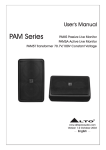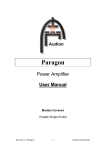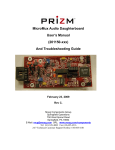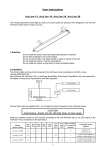Download DDS manual-V3-1 19 inch rackmount
Transcript
www.travel-vision.com Dish Diversity Switch INSTALLATION & USER’S MANUAL Version 3.3 as from software 1.0.13 October 2018 PREFACE Congratulations on your purchase of the Travel Vision DDS This manual was drawn up to provide you with all necessary information about the installation, the use and maintenance of this system. The Travel Vision Dish Diversity Switch was developed to fit the needs of ship owners to have an antenna switch that also does not depend on the brand and type of satellite antennas. WARNINGS and NOTES All details are up-to-date to the manual printing date. Travelvision BV cannot be held liable whatsoever for any errors that were made whilst compiling this manual. Travelvision BV reserves the right to introduce any modification deemed necessary due to development of the products and also reserves the right, without prior notice, to make amendments in this installation and user manual, as well as in the products, as described therein. Travel Vision ® is a registered trademark by Travelvision B.V. Please read this installation and user manual before putting your Travel Vision DDS into service. Any service and installation should exclusively be performed by qualified personnel. To reduce the risk of electric shock, do not remove the cover of the Dish Diversity Switch. There are no parts in the DDS that require service and maintenance from the user. Make sure that all wiring is adequately connected before putting the DDS into service. Turn the supply voltage off and disconnect it before carrying out any service to the system. Page 2 Content 1. System description 2. Hardware installation 2.1 General Installation 2.2 Coax cable routing 2.3 Wiring schematic 3. Installation and configuration 3.1 Equalise power levels Dish 1 and 2. 3.2 Level detection 3.3 Calibration 3.4 Default settings 3.5 Menu 4. Specifications 5. Warranty conditions page 4. page 5. page 5. page 5. page 6. page 7. page 7. page 7. page 7. page 8. page 9. page 10. page 11. Page 3 1. System Description Travel Vision’s Dish Diversity Switch was developed to fit the needs of ship owners to have an antenna switch that does not depend on the brand and type of satellite antennas. The Travel Vision Dish Diversity Switch doesn’t need to communicate with the antenna controller units. The Dish Diversity Switch takes RF-signal samples from both antennas and determines entirely autonomous which satellite antenna has the strongest signal. The signal from that antenna is then routed to a connected head-end or receivers. Page 4 2. Hardware Installation 2.1 General Installation The Dish Diversity Switch is provided with an Euro style Power cord and plug. Before start doing any installation, please make sure main power is disconnected. The system is designed to be installed in a 19inch cabinet rack. The Dish Diversity Switch has a standard height of 1U. The Dish Diversity Switch operates under embedded software control. If power is applied to the unit, the software will start automatically and no user intervention is needed. The embedded software can be updated using an USB memory stick. 2.2 Coax cable routing Interfacing the Dish Diversity Switch The red loops in the drawing above are coaxial loops that connect the output of the signal level detector to an input of the switch. By default the loops are placed onto the Horizontal low band input. This means that the coax cable from Dish1 LNB low Horizontal band shall be connected to input Detector Dish1 In. The Coax cable from Dish2 LNB Low Horizontal band should be connected to input Detector Dish 2 in. Any band can be used for signal strength measurement as long both detector inputs are connected to the same signal band. It’s preferred to use a signal band that has multiple steady carriers. Although the switch section was designed to give minimum attenuation and maximum flatness over the entire L-band, it does introduce a signal loss of approximately 3dB. The signal band that is routed through the Detector experiences an additional attenuation of approximately 1dB. This additional attenuation is mainly introduced by the F-connectors and the coaxial wiring internally and the loops externally. If the systems signal level overhead is smaller than 4 dB, low gain amplifiers must be used to compensate the additional losses introduced by the Dish Diversity Switch. Page 5 2.3 Wiring Schematic Page 6 3. Installation and configuration 3.1 Equalise power levels Dish 1 and 2. Before RF cables from both dishes are connected to the DDS, make sure the dBµV power levels from both dishes should be equalised in power. For example with amplifier or attenuator set both levels on 70 dBµV. 3.2 Level detection When main power and RF cables are connected, the software starts and will display the measured signal levels from Dish 1 and Dish 2. If the detector has no signal or a level that is too low, display will show <43 dB µV. If the level is too high display will show >84 dBµV The level displayed is in dB µV units, this level displayed cannot be compared to the levels that one would read from a spectrum analyzer. The used level detection measures the RF power across the entire L-band instead of a single transponder. 3.3 Calibration Calibration is done in factory, and DDS can be immediately used after installation. Although after reset in menu or firmware update the DDS should be calibrated again to measure the difference between the 2 input detectors inside the DDS. Calibration must be done with 1 antenna with a minimum 2 outputs, connected to both detector dish 1 and detector dish 2. How to calibrate?: 1. Align dish with twin or quad output LNB to satellite. 2. Set the dBµV power from the 2 outputs from dish equal. (for example with amplifier or attenuator set both outputs 70 dbµV) 3. Connect LNB output 1 to DDS detector dish 1 4. Connect LNB output 2 to DDS detector dish 2 5. Enter the installation menu by pressing the <Enter> ( ) and <Esc> ( ) keys for 4 seconds. 6. Then scroll down the menu pressing the ↓ key until Calibrate is displayed. 7. Then press <Enter> to start the calibration routine. At this point the control unit reads the RF-signals and compared against each other and stored into non volatile memory. If calibration is done leave the menu by pressing <Esc>. Page 7 3.4 Default Settings The following settings are default. They can be changed by the user. Changing these setting will affect the systems performance. We advise not to change any settings unless you are a certified mechanic. Setting Default Auto/Manual Switch Delay RF Power Threshold Backlight Backlight Intensity Auto 0 second 00,2 dB On maximum Page 8 3.5 Menu When a key, or combination of keys is pressed an user can enter different menu functions. To enter the settings menu, press Enter for 4 seconds. To enter installation menu, press Enter and Escape together for 4 seconds. When the switch is in automatic mode you can manually select an input by pressing the UP or Down key for 4 seconds. Please note that this menu is not available when the switch is in manual mode. Page 9 4. Specifications Power Supply Power cord plug type Dimensions Universal 100..240 Volt AC, 50..60 Hz 25 Watt maximum Euro 19 inch rack mount, 1U height. RF detector Frequency range Impedance Connectors Pass through loss RF level handling L-band (950..2150 MHz) 75 Ohm F-connector female (high performance type) <1dB typical 42dBµV to 84dBµV Switch Section Frequency range Impedance Connectors Pass through loss RF level handling Isolation between Ports Isolation Port to Port DC current path Maximum DC current L-band (950..2150 MHz) 75 Ohm F-connector female (high performance type) <3dB typical 42dBµV to 84dBµV (1Watt absolute maximum) > 30 dB typical > 35 dB typical All port have a DC pass (jumper selection pass no-pass) 800 mA Page 10 5. Warranty conditions 1. The warranty exclusively applies if the Travel Vision system was installed by any installation company (hereafter in these terms referred to as “dealer”), certified or qualified by Travelvision B.V. Due to stringent quality control and high requirements for the dealers, Travelvision B.V. guarantees the delivery of a properly functioning Travel Vision DDS system. Should, in case of normal use of the Travel Vision DDS system, any defect occur with 12 months after installation, as a result of a manufacturing defect and/or material defect, then this defect will be resolved under the below mentioned warranty conditions. The warranty registration must be submitted promptly, yet 1 month after installation of the Travel Vision system at the latest to Travelvision B.V., by the dealer. The warranty is non-transferable. Travelvision B.V. has a help-desk, which the dealer can call on for free advice with regard to installation, disassembly and repair of the Travel Vision system. The owner of the Travel Vision system should, at first observation of a defect, notify the dealer promptly and enable him to identify this defect. If, in the dealer’s view, a defect can be resolved on site, then the dealer is authorised to carry out the repair on site. In case this appears to be impossible, the dealer will, under no obligation install a replacement system, disassemble the Travel Vision system and take it for repair at its branch or, after consultation with the help-desk send the system to Travelvision B.V. respectively, to have repair carried out there. Travelvision B.V. reserves the right to use the services of third parties or refer to them respectively, in the event of warranty processing or offering advice. Travelvision B.V. reserves the right to determine at its sole discretion whether the defect is a result of improper use and/or incorrect installation of the Travel Vision system, in which case(s) applicable, the right to claim under warranty will become invalid and will, as such, be denied. Travelvision B.V. is not responsible for the suitability of the Travel Vision system, other than for the purpose that Travelvision B.V. has committed to in the Installation and user manual. Travelvision B.V. will therefore accept no liability whatsoever for damage as a result thereof. Travelvision B.V. is not responsible for any defect on the Travel Vision system and/or its functionality, if this is the consequence of an external calamity or because of the improper or incomplete functioning of products and/or services of third parties, or their inaccessibility. Travelvision B.V. will therefore accept no liability whatsoever, for any damage as a result thereof. 2. 3. 4. 5. 6. 7. 8. 9. 10. 13. Page 11 www.travel-vision.com Dish Diversity Switch INSTALLATION & USER’S MANUAL Version 3.3 as from software 1.0.13 October 2018 PREFACE Congratulations on your purchase of the Travel Vision DDS This manual was drawn up to provide you with all necessary information about the installation, the use and maintenance of this system. The Travel Vision Dish Diversity Switch was developed to fit the needs of ship owners to have an antenna switch that also does not depend on the brand and type of satellite antennas. WARNINGS and NOTES All details are up-to-date to the manual printing date. Travelvision BV cannot be held liable whatsoever for any errors that were made whilst compiling this manual. Travelvision BV reserves the right to introduce any modification deemed necessary due to development of the products and also reserves the right, without prior notice, to make amendments in this installation and user manual, as well as in the products, as described therein. Travel Vision ® is a registered trademark by Travelvision B.V. Please read this installation and user manual before putting your Travel Vision DDS into service. Any service and installation should exclusively be performed by qualified personnel. To reduce the risk of electric shock, do not remove the cover of the Dish Diversity Switch. There are no parts in the DDS that require service and maintenance from the user. Make sure that all wiring is adequately connected before putting the DDS into service. Turn the supply voltage off and disconnect it before carrying out any service to the system. Page 2 Content 1. System description 2. Hardware installation 2.1 General Installation 2.2 Coax cable routing 2.3 Wiring schematic 3. Installation and configuration 3.1 Equalise power levels Dish 1 and 2. 3.2 Level detection 3.3 Calibration 3.4 Default settings 3.5 Menu 4. Specifications 5. Warranty conditions page 4. page 5. page 5. page 5. page 6. page 7. page 7. page 7. page 7. page 8. page 9. page 10. page 11. Page 3 1. System Description Travel Vision’s Dish Diversity Switch was developed to fit the needs of ship owners to have an antenna switch that does not depend on the brand and type of satellite antennas. The Travel Vision Dish Diversity Switch doesn’t need to communicate with the antenna controller units. The Dish Diversity Switch takes RF-signal samples from both antennas and determines entirely autonomous which satellite antenna has the strongest signal. The signal from that antenna is then routed to a connected head-end or receivers. Page 4 2. Hardware Installation 2.1 General Installation The Dish Diversity Switch is provided with an Euro style Power cord and plug. Before start doing any installation, please make sure main power is disconnected. The system is designed to be installed in a 19inch cabinet rack. The Dish Diversity Switch has a standard height of 1U. The Dish Diversity Switch operates under embedded software control. If power is applied to the unit, the software will start automatically and no user intervention is needed. The embedded software can be updated using an USB memory stick. 2.2 Coax cable routing Interfacing the Dish Diversity Switch The red loops in the drawing above are coaxial loops that connect the output of the signal level detector to an input of the switch. By default the loops are placed onto the Horizontal low band input. This means that the coax cable from Dish1 LNB low Horizontal band shall be connected to input Detector Dish1 In. The Coax cable from Dish2 LNB Low Horizontal band should be connected to input Detector Dish 2 in. Any band can be used for signal strength measurement as long both detector inputs are connected to the same signal band. It’s preferred to use a signal band that has multiple steady carriers. Although the switch section was designed to give minimum attenuation and maximum flatness over the entire L-band, it does introduce a signal loss of approximately 3dB. The signal band that is routed through the Detector experiences an additional attenuation of approximately 1dB. This additional attenuation is mainly introduced by the F-connectors and the coaxial wiring internally and the loops externally. If the systems signal level overhead is smaller than 4 dB, low gain amplifiers must be used to compensate the additional losses introduced by the Dish Diversity Switch. Page 5 2.3 Wiring Schematic Page 6 3. Installation and configuration 3.1 Equalise power levels Dish 1 and 2. Before RF cables from both dishes are connected to the DDS, make sure the dBµV power levels from both dishes should be equalised in power. For example with amplifier or attenuator set both levels on 70 dBµV. 3.2 Level detection When main power and RF cables are connected, the software starts and will display the measured signal levels from Dish 1 and Dish 2. If the detector has no signal or a level that is too low, display will show <43 dB µV. If the level is too high display will show >84 dBµV The level displayed is in dB µV units, this level displayed cannot be compared to the levels that one would read from a spectrum analyzer. The used level detection measures the RF power across the entire L-band instead of a single transponder. 3.3 Calibration Calibration is done in factory, and DDS can be immediately used after installation. Although after reset in menu or firmware update the DDS should be calibrated again to measure the difference between the 2 input detectors inside the DDS. Calibration must be done with 1 antenna with a minimum 2 outputs, connected to both detector dish 1 and detector dish 2. How to calibrate?: 1. Align dish with twin or quad output LNB to satellite. 2. Set the dBµV power from the 2 outputs from dish equal. (for example with amplifier or attenuator set both outputs 70 dbµV) 3. Connect LNB output 1 to DDS detector dish 1 4. Connect LNB output 2 to DDS detector dish 2 5. Enter the installation menu by pressing the <Enter> ( ) and <Esc> ( ) keys for 4 seconds. 6. Then scroll down the menu pressing the ↓ key until Calibrate is displayed. 7. Then press <Enter> to start the calibration routine. At this point the control unit reads the RF-signals and compared against each other and stored into non volatile memory. If calibration is done leave the menu by pressing <Esc>. Page 7 3.4 Default Settings The following settings are default. They can be changed by the user. Changing these setting will affect the systems performance. We advise not to change any settings unless you are a certified mechanic. Setting Default Auto/Manual Switch Delay RF Power Threshold Backlight Backlight Intensity Auto 0 second 00,2 dB On maximum Page 8 3.5 Menu When a key, or combination of keys is pressed an user can enter different menu functions. To enter the settings menu, press Enter for 4 seconds. To enter installation menu, press Enter and Escape together for 4 seconds. When the switch is in automatic mode you can manually select an input by pressing the UP or Down key for 4 seconds. Please note that this menu is not available when the switch is in manual mode. Page 9 4. Specifications Power Supply Power cord plug type Dimensions Universal 100..240 Volt AC, 50..60 Hz 25 Watt maximum Euro 19 inch rack mount, 1U height. RF detector Frequency range Impedance Connectors Pass through loss RF level handling L-band (950..2150 MHz) 75 Ohm F-connector female (high performance type) <1dB typical 42dBµV to 84dBµV Switch Section Frequency range Impedance Connectors Pass through loss RF level handling Isolation between Ports Isolation Port to Port DC current path Maximum DC current L-band (950..2150 MHz) 75 Ohm F-connector female (high performance type) <3dB typical 42dBµV to 84dBµV (1Watt absolute maximum) > 30 dB typical > 35 dB typical All port have a DC pass (jumper selection pass no-pass) 800 mA Page 10 5. Warranty conditions 1. The warranty exclusively applies if the Travel Vision system was installed by any installation company (hereafter in these terms referred to as “dealer”), certified or qualified by Travelvision B.V. Due to stringent quality control and high requirements for the dealers, Travelvision B.V. guarantees the delivery of a properly functioning Travel Vision DDS system. Should, in case of normal use of the Travel Vision DDS system, any defect occur with 12 months after installation, as a result of a manufacturing defect and/or material defect, then this defect will be resolved under the below mentioned warranty conditions. The warranty registration must be submitted promptly, yet 1 month after installation of the Travel Vision system at the latest to Travelvision B.V., by the dealer. The warranty is non-transferable. Travelvision B.V. has a help-desk, which the dealer can call on for free advice with regard to installation, disassembly and repair of the Travel Vision system. The owner of the Travel Vision system should, at first observation of a defect, notify the dealer promptly and enable him to identify this defect. If, in the dealer’s view, a defect can be resolved on site, then the dealer is authorised to carry out the repair on site. In case this appears to be impossible, the dealer will, under no obligation install a replacement system, disassemble the Travel Vision system and take it for repair at its branch or, after consultation with the help-desk send the system to Travelvision B.V. respectively, to have repair carried out there. Travelvision B.V. reserves the right to use the services of third parties or refer to them respectively, in the event of warranty processing or offering advice. Travelvision B.V. reserves the right to determine at its sole discretion whether the defect is a result of improper use and/or incorrect installation of the Travel Vision system, in which case(s) applicable, the right to claim under warranty will become invalid and will, as such, be denied. Travelvision B.V. is not responsible for the suitability of the Travel Vision system, other than for the purpose that Travelvision B.V. has committed to in the Installation and user manual. Travelvision B.V. will therefore accept no liability whatsoever for damage as a result thereof. Travelvision B.V. is not responsible for any defect on the Travel Vision system and/or its functionality, if this is the consequence of an external calamity or because of the improper or incomplete functioning of products and/or services of third parties, or their inaccessibility. Travelvision B.V. will therefore accept no liability whatsoever, for any damage as a result thereof. 2. 3. 4. 5. 6. 7. 8. 9. 10. 13. Page 11















